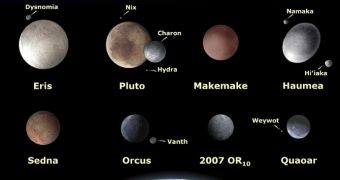A recent study reveals that the reason Haumea gets its distinctive glimmer in space is because its surface may be covered with ice. The study was conducted by experts with the European Space Agency (ESA), and was detailed in a recent press release.
According to the document, it would seem that the dwarf planet goes through cycles of heating and rapid cooling. Together, these significant temperature variations lead to the formation of a thin ice shell over the celestial body's surface.
Haumea was discovered only in 2004, and was immediately classified as a dwarf planet. It is smaller than Eris and Pluto, but larger than Sedna, Makemake and Orcus. It also features two moons, called Namaka and Hi'iaka.
The object lies in the Kuiper Belt, way beyond the orbit of Neptune. Ever since it was discovered, the dwarf planet has been observed to gleam, something that mystified astronomers, Wired reports.
In the past, studies of Haumea determined that it was covered with amorphous, glass-like ice, but the new investigation shows that the ice actually consists of fresh, highly organized crystals.
“Since solar radiation constantly destroys the crystalline structure of ice on the surface, energy sources are required to keep it organized,” explains ESA planetary scientist Benoit Carry, in a press release issued on Thursday, May 12.
Details of the new study will appear in a paper that has already been accepted for publication in an upcoming issue of the esteemed scientific journal Astronomy and Astrophysics. Interestingly, Haumea is located at about 43 astronomical units (AU) from the Sun.
An AU is the mean distance between Earth and the Sun, or about 93 million miles. But this distance is nothing for the Very Large Telescope (VLT). Experts used the Chile-based instrument, which is operated by the European Southern Observatory (ESO), to conduct the new observations.
The study revealed that the ices on Haumea's surface are constantly being replenished, most likely by the heat produced by radioactive elements in its interior. Add to this the gravitational kneading from Hi’iaka and Namaka, and you get a lot of heat.
These elevated temperatures constantly melt off the ice on Haumea's surface, but then the stuff refreezes all over again, in the same organized, crystalline patterns.

 14 DAY TRIAL //
14 DAY TRIAL //